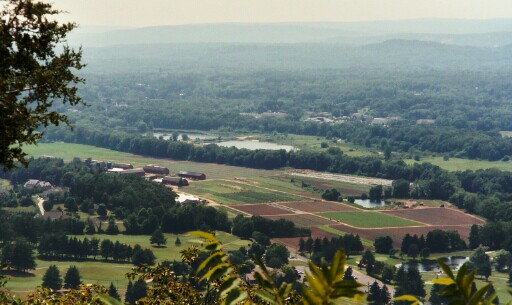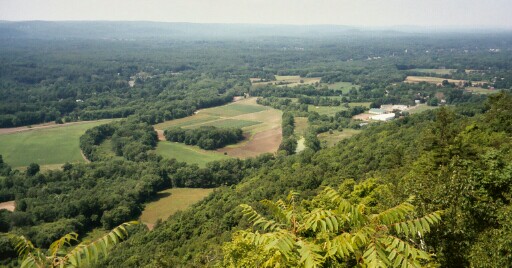August 09, 2003
Views of Farmington River from Talcott Mountain, Near King Phillip's Cave
Connecticut's traprock formations shape the course of tributaries of the ancient river. One is the Farmington River, which winds down from Massachusetts into the bottom lands to the west of the Metacomet Ridge. Part of the ridge is Talcott Mountain, a long, precipitous wooded ledge just west of Hartford.
As if searching for a way east to join the Connecticut, the Farmington flows south through New Hartford as the scenic rapids in "Satan's Kingdom" into Canton , then Collinsville and Farmington, where it turns back north, through Avon and Simsbury, then east to rumble through the Class III rapids of Tariffville Gorge. It finally slides into the Connecticut River in Windsor at the site of the first English settlement in Connecticut, then known as "The Island." The land was originally granted to Joseph Loomis in 1639 and is the present day site of the Loomis Chaffee School just north of Hartford.
We climbed the walking trail along the ridge in Talcott Mountain State Park at the high point of which stands the Heublein Tower, a 165-foot structure built in 1914.
From the trail we enjoyed views of the Farmington River among the tobacco barns and cropland to the southwest, with another traprock range of hills in the far distance:

And views to the northwest, where oxbow ponds lined with rows of trees in the foreground give way to the reforested acres of Simsbury, beyond which lie the Litchfield Hills in the northwest corner of the state and the Berkshires in southwestern Massachusetts.

This was the vista from which, in 1676, the Indian leader "King Philip" is said to have watched as his warriors burned Simsbury to the ground. The large cave in the sheer west face of the mountain is known as King Philip's Cave and the ridge, of which Talcott Mountain is a part, the Metacomet Ridge. The burning of Simsbury was but one incident in the extended conflict between Indian tribes and English colonialists known as "King Philip's War," one of the bloodiest in America's history, ranging from Massachusetts Bay to Rhode Island and Connecticut. But that's another story: King Philip's War: The History and Legacy of America's Forgotten Conflict.
DougSimpson.com/river
Posted by dougsimpson at August 9, 2003 10:00 AM | TrackBackDoug - In your second paragraph on the course of the Farmington River. The river goes through New Hartford first, then through Canton, Farmington, Simsbury to eventually discharge into the CT River in Windsor. It does not flow back to New Hartford.
Posted by: M. Mischak at October 4, 2003 08:18 AMMike, thanks for the correction, which I've incorporated into the main posting above.
Doug Simpson
Posted by: Doug Simpson at October 5, 2003 05:46 AM